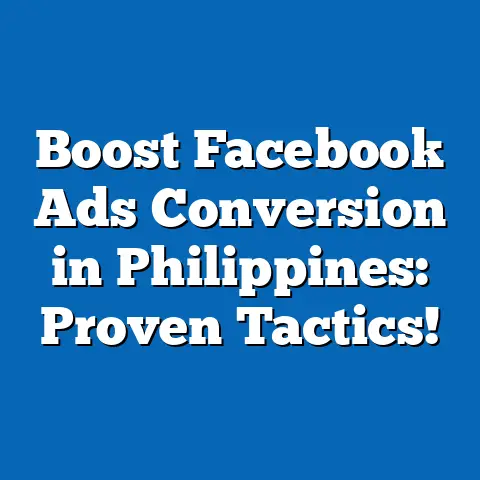Boost Sales in Philippines: Facebook Ads Traffic Secrets!
Boost Sales in Philippines: Facebook Ads Traffic Secrets!
Introduction: Busting the Myth About Facebook Ads Metrics
There’s a common myth I often hear from Filipino small business owners and marketers, especially those who are just dipping their toes into digital advertising: “Facebook ad metrics are too complicated to understand and don’t really help me boost sales.” I get it. When I started managing Facebook ads for local businesses in the Philippines, I felt overwhelmed by the jargon, the numbers, and the endless dashboards. But I quickly realized that this myth couldn’t be further from the truth.
In fact, understanding Facebook ad metrics is like having a map and compass in the vast jungle of online marketing — without it, you’re wandering blind. With it, you can find shortcuts, avoid pitfalls, and reach your destination faster. This article is my way of sharing what I’ve learned through years of running campaigns for Filipino SMBs and helping them grow their sales.
I will break down the essential Facebook ads traffic metrics you need to know, explain why they matter, how to interpret them, and provide real-world examples and local case studies. More importantly, I’ll share actionable insights so you can make data-driven decisions that truly boost your sales in the Philippines.
Whether you’re a sari-sari store owner in Cebu or an online fashion retailer in Manila, these metrics will help you get the most out of your Facebook advertising budget.
Why Facebook Ads Metrics Matter for Filipino Businesses
Facebook remains one of the most popular social media platforms in the Philippines with over 80 million active users as of 2024. For local businesses, this means access to a massive audience that spans urban centers and provincial towns alike.
Yet many SMBs struggle with:
- Wasting money on ads that get little response
- Not knowing if their ads actually lead to sales
- Feeling confused by Facebook’s data and metrics dashboard
I’ve seen countless Filipino entrepreneurs pour money into ads without tracking or understanding key performance indicators (KPIs). It’s like fishing without a net—you might catch something, but it’s mostly guesswork.
Here’s why metrics matter:
- Measure Effectiveness: Know what ads are working and which aren’t.
- Optimize Budget: Stop spending on ads that don’t convert.
- Understand Customers: Learn who clicks, who buys, and what appeals to them.
- Make Smarter Decisions: Use data, not gut feel, to plan campaigns.
- Increase ROI: More sales with less ad spend.
Think of Facebook ads as a machine. Metrics are the dials and gauges telling you how well it’s running. Without this feedback, you risk breakdowns and losses.
1. Click-Through Rate (CTR)
What is CTR?
Click-Through Rate (CTR) is the percentage of people who see your ad (impressions) and actually click on it. It measures how engaging or relevant your ad is to your target audience. CTR=(ClicksImpressions)×100\text{CTR} = \left(\frac{\text{Clicks}}{\text{Impressions}}\right) \times 100
For example, if 1,000 people see your ad and 20 click it, your CTR is 2%.
Why CTR Matters
CTR is often the first sign of how well your ad copy, images, or videos resonate with your audience. A low CTR means people see your ad but don’t find it interesting or relevant enough to click.
In my experience working with Filipino SMBs:
- Ads with generic copy or stock photos often have CTR below 0.5%.
- Ads tailored with local language (Tagalog or regional dialects), cultural references, or promos get CTRs above 1.5%.
- Video ads usually generate higher CTR than static images by 15-25%.
How to Interpret CTR
- Below 0.5%: Your ad needs improvement; try different creatives or targeting.
- 0.5% to 1%: Average but can be optimized.
- Above 1%: You’re doing well; the ad is engaging your audience.
A CTR of 1.5% or higher is excellent for Philippine markets due to diverse consumer tastes and competition.
How CTR Relates to Other Metrics
CTR directly impacts your Cost Per Click (CPC). Facebook rewards ads with high CTR by lowering CPC because they consider these ads relevant and user-friendly.
High CTR also improves your Ad Relevance Score (now called Quality Ranking). A better ranking means Facebook will show your ads more often at lower costs.
Local Example: Boosting CTR with Language and Culture
I managed a campaign for a local rice cake seller in Laguna. Initially, their ad showed a generic product image with English text. CTR hovered around 0.4%. We changed the copy to “Tikman ang tunay na lasa ng puto bumbong ni Lola!” with vibrant photos of freshly made rice cakes. The CTR jumped to 2.7% within one week.
This shows how using local language and appealing visuals can significantly improve engagement.
2. Cost Per Click (CPC)
What is CPC?
Cost Per Click (CPC) measures how much you pay every time someone clicks your ad. CPC=Total Ad SpendNumber of Clicks\text{CPC} = \frac{\text{Total Ad Spend}}{\text{Number of Clicks}}
For example, if you spent ₱500 and got 50 clicks, CPC is ₱10 per click.
Why CPC Matters
CPC tells you how efficiently you’re driving traffic to your website or landing page. A low CPC means you get more visits for less money.
For many Filipino SMBs with tight budgets, controlling CPC is crucial because every peso counts.
How to Interpret CPC
CPC varies by industry and competition:
- For small retail or e-commerce stores in the Philippines, ₱5 – ₱15 per click is typical.
- For competitive sectors like real estate or insurance, CPC can go above ₱20.
- If CPC suddenly spikes without reason, check for targeting issues or increased competition.
How CPC Relates to Other Metrics
CPC works hand-in-hand with CTR and conversion rate:
- Low CPC + high CTR + high conversion = winning formula
- Low CPC + low conversion = wasted clicks; check landing page
- High CPC + low conversion = urgent optimization needed
Practical Tip: Narrowing Audience to Lower CPC
When I worked with a Manila-based fashion retailer targeting “women aged 18-45,” CPC was around ₱18. By focusing on “women aged 25-35 interested in local Filipino brands,” we lowered CPC to ₱8 while improving traffic quality.
Local Insight: Mobile-first Filipinos
Since majority of Filipinos access Facebook through mobile phones with varying internet speeds, ads optimized for mobile load times tend to have lower CPC because users interact faster without frustration.
3. Conversion Rate
What is Conversion Rate?
Conversion rate is the percentage of people who clicked your ad and completed a desired action like making a purchase or signing up. Conversion Rate=(ConversionsClicks)×100\text{Conversion Rate} = \left(\frac{\text{Conversions}}{\text{Clicks}}\right) \times 100
If you get 200 clicks but only 10 purchases, conversion rate is 5%.
Why Conversion Rate Matters
Clicks alone don’t mean sales. Conversion rate shows how effective your offer and website/landing page are at turning visitors into customers.
In my experience with Filipino SMBs selling affordable goods online:
- Conversion rates between 2% to 5% are typical.
- Higher conversion rates indicate strong trust and good user experience.
- Lower rates suggest issues like confusing checkout process or unclear offers.
How to Interpret Conversion Rate
- Below 2%: Need serious optimization; check website speed, mobile-friendliness, and trust signals.
- 2%-5%: Healthy range for many product types.
- Above 5%: Excellent performance; keep refining.
How Conversion Rate Relates to Other Metrics
Conversion rate combined with CPC determines your Cost Per Acquisition (CPA) — how much it costs you to get a paying customer.
High conversion rate means you can afford higher CPC because more clicks turn into sales.
Case Study: Simplifying Checkout Boosts Conversion
For a Cebu gadget retailer I worked with, conversion was just 1%. After streamlining checkout—removing unnecessary form fields and adding “Cash on Delivery” option popular with Filipinos—conversion jumped to 4%.
Sales tripled without increasing ad spend.
4. Cost Per Acquisition (CPA)
What is CPA?
Cost Per Acquisition measures the amount spent on ads divided by number of conversions/sales. CPA=Total Ad SpendNumber of Conversions\text{CPA} = \frac{\text{Total Ad Spend}}{\text{Number of Conversions}}
If you spent ₱10,000 on ads that resulted in 50 sales, CPA is ₱200 per sale.
Why CPA Matters
CPA tells you if your campaign is profitable. If you’re paying more per customer than what they bring in profit, it’s unsustainable.
In the Philippines where consumers often look for value deals, controlling CPA is key to long-term success.
How to Interpret CPA
Your target CPA depends on:
- Average order value (AOV)
- Profit margins
- Customer lifetime value (CLV)
If AOV is ₱500 and profit margin is 40%, ideal CPA should be below ₱200 to make money.
How CPA Relates to Other Metrics
CPA depends on CPC and conversion rate: CPA=CPCConversion RateCPA = \frac{CPC}{\text{Conversion Rate}}
Lowering CPC or improving conversion rate reduces CPA.
Local Example: Retargeting Lowers CPA
For a Quezon City-based bakery with an average order value of ₱300, we targeted warm leads—people who visited their menu but didn’t order—and reduced CPA by 40%. This approach cost less than cold outreach campaigns and brought better customers.
5. Impressions & Reach
What Are Impressions and Reach?
- Impressions: Number of times your ad was shown.
- Reach: Number of unique people who saw your ad at least once.
If one person sees an ad three times, that counts as three impressions but one reach.
Why These Matter
Reach tells you how many unique people saw your ad; impressions tell you frequency—how often each person saw it.
In the Philippines’ fast-scrolling Facebook feeds, frequency between 2-3 times per week strikes balance between brand recall and avoiding annoyance (called ad fatigue).
How to Interpret Impressions & Reach
High reach but low impressions mean many people saw the ad once; this may not be enough for brand awareness.
High impressions but low reach mean a smaller audience sees your ad repeatedly; risk of irritation increases here.
Relation to Other Metrics
Frequency (impressions divided by reach) affects CTR and conversion rates:
- Low frequency (<1.5) may mean insufficient exposure.
- High frequency (>4) risks annoying users leading to negative feedback.
Practical Example: Managing Frequency for Local App Launch
We launched a sari-sari store app targeting Mindoro residents and capped frequency at 3 per week. This maintained steady engagement without spooking potential buyers with repetitive ads.
6. Return on Ad Spend (ROAS)
What is ROAS?
ROAS measures revenue generated per peso spent on advertising: ROAS=Revenue from AdsAd SpendROAS = \frac{\text{Revenue from Ads}}{\text{Ad Spend}}
If you spend ₱10,000 on ads and earn ₱40,000 in sales linked to those ads, ROAS is 4.
Why ROAS Matters
ROAS shows if your campaigns are profitable:
- ROAS above 1 means your campaign earns more than it spends.
- Filipino SMBs aim for ROAS between 3–5 depending on product margins.
How to Interpret ROAS
Higher ROAS means better efficiency:
- Below 1: Losing money
- 1–3: Breaking even or slight profit
- Above 3: Good returns; enough profit for growth
Relation to Other Metrics
ROAS depends on CPA, conversion rate, average order value, and CPC working together effectively.
Case Study: Growing ROAS from Campaign Optimization
A Pampanga furniture seller started at ROAS=1.5—barely breaking even. By shifting focus to upselling complementary items via dynamic product ads on Facebook and retargeting cart abandoners, we raised ROAS to 4 in two months without increasing budget.
Additional Important Metrics Filipino Marketers Should Know
Beyond these core metrics, here are some other useful ones I’ve found valuable when working with Filipino SMBs:
7. Ad Frequency
Frequency shows average number of times a user sees your ad: Frequency=ImpressionsReach\text{Frequency} = \frac{\text{Impressions}}{\text{Reach}}
Frequency helps identify if users are seeing ads too often or not enough:
- Frequency too low: Ads not memorable
- Frequency too high: Can cause ad fatigue and negative reactions
In Philippine markets where attention span online can be short due to many distractions, frequency between 2–3 per week is ideal for most campaigns.
8. Landing Page Views vs Link Clicks
Facebook distinguishes between people who click links vs those who actually wait for the landing page to load (“Landing Page Views”).
This distinction matters because:
- Many Filipinos use slow internet connections.
- High link clicks but low landing page views suggest poor user experience or slow site speed causing drop-offs before purchase actions.
Improving website speed can increase landing page views and ultimately conversions.
9. Engagement Rate
Engagement rate measures interactions like likes, shares, comments divided by impressions or reach: Engagement Rate=EngagementsImpressions or Reach×100\text{Engagement Rate} = \frac{\text{Engagements}}{\text{Impressions or Reach}} \times 100
Higher engagement can improve organic reach through Facebook’s algorithm which rewards content that gets interaction.
For Filipino brands using community-building strategies or storytelling in ads, engagement rate is critical besides just sales metrics.
Practical Strategies Using These Metrics: Actionable Tips for Filipino SMBs
Here’s how you can use these insights in day-to-day Facebook marketing:
Step 1: Start with Clear Goals
Define what “boost sales” means for you — more website orders? In-store visits? Lead signups? Your goal guides which metrics matter most.
Step 2: Use Simple Dashboards & Track Regularly
Use Facebook Ads Manager regularly. Set up custom reports focusing on CTR, CPC, CPA & ROAS for easy monitoring without drowning in data overload.
Step 3: Test Small & Learn Fast
Run small-budget tests comparing different audiences & creatives. Use CTR & CPC early on to find what attracts clicks before scaling up spend.
Step 4: Optimize Landing Pages
High clicks but low conversions? Improve website speed especially for mobile users in provinces with slower internet. Add trust badges like “Cash on Delivery available” — very important for Pinoys wary of online scams.
Step 5: Use Retargeting Wisely
Retarget visitors who engaged but didn’t buy. Retargeting has lower CPA because these are warm leads already familiar with your brand or product.
Step 6: Localize Content & Language
Ads using Tagalog or regional dialects perform better; add colloquial phrases like “Sulit na sulit!”, “Bili na!”, “Tipid tips!” which resonate deeply with Filipino audiences.
Step 7: Monitor Frequency & Avoid Fatigue
Keep frequency between 2–3 times per user per week to maintain interest without annoying people who might block or hide your ads otherwise.
Case Studies from Philippine SMBs Using Facebook Ads Metrics
Case Study A: Online Boutique in Manila
The client struggled with high CPC (<del>₱20) and low ROAS (</del>1). After narrowing targeting based on interests in local Filipino fashion brands plus optimizing creatives using Tagalog slang (“Astig na damit!”), CTR jumped from 0.7% to 2%. CPC dropped by half; conversion rate improved from 1% to 3%. Within two months ROAS hit 4 —four pesos earned per peso spent—allowing them to scale confidently while increasing monthly sales by over 150%.
Case Study B: Sari-Sari Store Delivery Service
Initially had decent CTR (1%) but conversion was low (around 1%). We optimized their mobile landing page loading time from 8 seconds down to under 3 seconds—a critical improvement given many rural users’ slow internet connections. Also added “Buy Now Pay Later” payment options popular among budget-conscious clients. Conversion rate doubled; CPA dropped by nearly half; monthly revenue doubled within three months while maintaining same budget.
Case Study C: Bakery in Quezon City
Sales fluctuated due to inconsistent foot traffic during COVID lockdowns. They wanted online orders through Facebook but had high CPA (~₱300). By segmenting their audience into cold leads vs warm leads (those who viewed menu but didn’t order), we created retargeting campaigns reducing CPA by over 40%. Added promos like “Free delivery above ₱500” which boosted average order value from ₱300 to ₱450—further improving ROAS from near breakeven to healthy profits around ROAS=3.5 within two months.
Common Challenges Filipino Marketers Face & How Metrics Help Solve Them
| Challenge | Metric Focus | Solution |
|---|---|---|
| Limited budget wastage | CTR & CPC | Test creatives/audience before scaling |
| Low website sales despite clicks | Conversion Rate & Landing Page Views | Optimize website/mobile UX |
| High cost per sale | CPA & Retargeting | Retarget warm leads; narrow audience |
| Ad fatigue | Frequency | Limit frequency; refresh creatives |
| Difficulty proving ROI | ROAS | Link offline/online sales data with FB metrics |
Final Words: Metrics Are Your Sales Compass
Tracking Facebook ads metrics isn’t about drowning yourself in numbers—it’s about gaining clear signals that guide smarter decisions every day.
Every peso invested deserves scrutiny because Filipino customers expect value for their money—and so should you as a business owner!
Learn these metrics well:
- Click Through Rate (CTR)
- Cost Per Click (CPC)
- Conversion Rate
- Cost Per Acquisition (CPA)
- Impressions & Reach
- Return On Ad Spend (ROAS)
- Additional supportive metrics like Frequency & Engagement Rate
Together they paint a complete picture showing what works locally—from Metro Manila’s busy streets down to remote Visayan towns—helping you boost your sales sustainably with Facebook ads tailored for the Philippine market’s unique behaviors and preferences.
Start small but think big—use data wisely—and watch your business grow!
If you want help setting up metric tracking dashboards or crafting localized Facebook ad campaigns designed specifically for Filipino SMBs like yours, just ask! I’m here to help turn those numbers into real peso profits!






